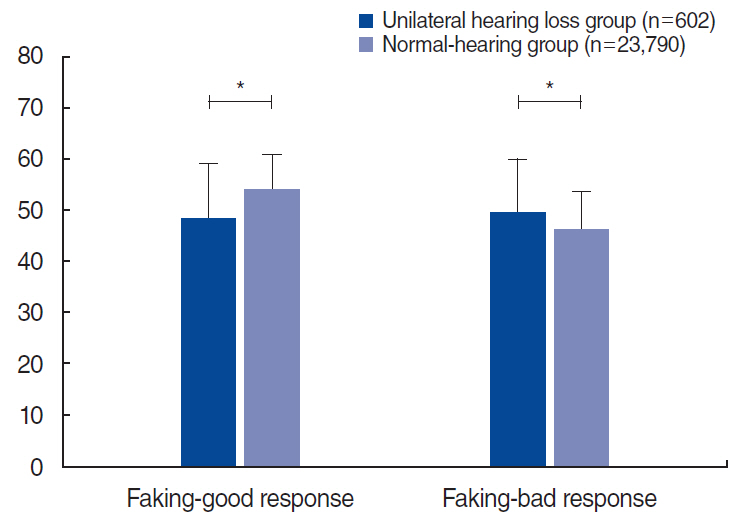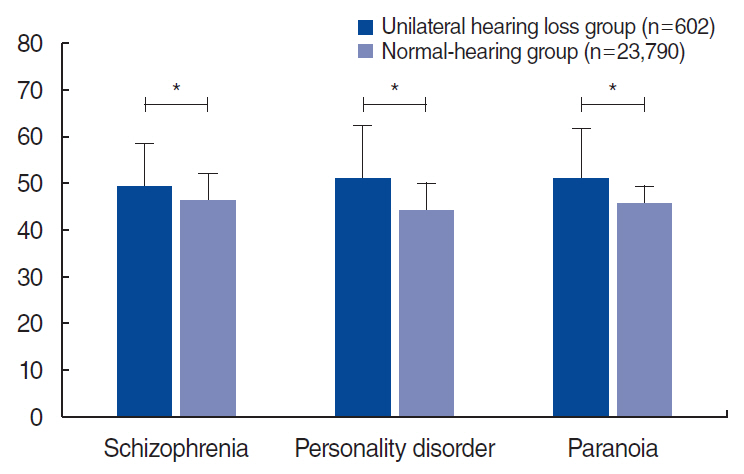Clin Exp Otorhinolaryngol.
2021 Feb;14(1):82-87. 10.21053/ceo.2020.00283.
Increased Risk of Psychopathological Abnormalities in Subjects With Unilateral Hearing Loss: A Cross-Sectional Study
- Affiliations
-
- 1Department of Otorhinolaryngology-Head and Neck Surgery, Seoul National University Bundang Hospital, Seongnam, Korea
- 2Department of Internal Medicine, Chungbuk National University Hospital, Chungbuk National University College of Medicine, Cheongju, Korea
- 3Department of Psychiatry, Seoul National University Bundang Hospital, Seongnam, Korea
- 4Department of Otorhinolaryngology-Head and Neck Surgery, Chungbuk National University Hospital, Chungbuk National University College of Medicine, Cheongju, Korea
- KMID: 2512885
- DOI: http://doi.org/10.21053/ceo.2020.00283
Abstract
Objectives
. Although unilateral hearing loss (UHL) has been proven to be associated with educational and behavioral problems, few studies have investigated psychopathological abnormalities in this population. The aim of this study was to evaluate the psychopathological influence of UHL among Korean 19-year-old males.
Methods
. The authors retrospectively compared the objective personality test profiles of 602 subjects with UHL with those of 23,790 peers with normal hearing. All participants in the current study were 19-year-old males who underwent a physical examination and completed the Korean Military Multiphasic Personality Inventory for conscription at the Military Manpower Administration from February 2015 to December 2016.
Results
. Significantly higher scores were found on neurosis scales in the UHL group than in the normal-hearing group (50.9± 10.8 vs. 44.9±6.0 for anxiety; 51.0±10.5 vs. 44.9±5.2 for depression; 51.1±10.4 vs. 45.1±6.81 for somatization, all P<0.001). The psychopathy scales were also significantly higher in the UHL group than in the normal-hearing group (49.3±9.4 vs. 46.3±5.7 for schizophrenia; 51.1±11.2 vs. 44.3±5.8 for personality disorders; 51.1±10.5 vs. 45.7±3.7 for paranoia, all P<0.001).
Conclusion
. Nineteen-year-old males with UHL tended to have more abnormal results on personality tests than controls with normal hearing, suggesting that UHL may be related with a higher risk of psychopathology.
Figure
Cited by 1 articles
-
Factors Influencing Hearing Aid Adoption in Patients With Hearing Loss in Korea
Young Sang Cho, Ga-Young Kim, Jae Hyuk Choi, Sin Sung Baek, Hye Yoon Seol, Jihyun Lim, Jin Gyun Park, Il Joon Moon
J Korean Med Sci. 2021;37(2):e11. doi: 10.3346/jkms.2022.37.e11.
Reference
-
1. Watkin P, Baldwin M. The longitudinal follow up of a universal neonatal hearing screen: the implications for confirming deafness in childhood. Int J Audiol. 2012; Jul. 51(7):519–28.
Article2. Johnson JL, White KR, Widen JE, Gravel JS, James M, Kennalley T, et al. A multicenter evaluation of how many infants with permanent hearing loss pass a two-stage otoacoustic emissions/automated auditory brainstem response newborn hearing screening protocol. Pediatrics. 2005; Sep. 116(3):663–72.
Article3. Ross DS, Visser SN, Holstrum WJ, Qin T, Kenneson A. Highly variable population-based prevalence rates of unilateral hearing loss after the application of common case definitions. Ear Hear. 2010; Feb. 31(1):126–33.
Article4. Agrawal Y, Platz EA, Niparko JK. Prevalence of hearing loss and differences by demographic characteristics among US adults: data from the National Health and Nutrition Examination Survey, 1999-2004. Arch Intern Med. 2008; Jul. 168(14):1522–30.5. Nakano A, Arimoto Y, Matsunaga T. Cochlear nerve deficiency and associated clinical features in patients with bilateral and unilateral hearing loss. Otol Neurotol. 2013; Apr. 34(3):554–8.
Article6. Song JJ, Choi HG, Oh SH, Chang SO, Kim CS, Lee JH. Unilateral sensorineural hearing loss in children: the importance of temporal bone computed tomography and audiometric follow-up. Otol Neurotol. 2009; Aug. 30(5):604–8.7. Lieu JE. Management of children with unilateral hearing loss. Otolaryngol Clin North Am. 2015; Dec. 48(6):1011–26.
Article8. Park E, Lee G, Jung HH, Im GJ. Analysis of inner ear anomalies in unilateral congenital aural atresia combined with microtia. Clin Exp Otorhinolaryngol. 2019; May. 12(2):176–80.
Article9. Peckham CS, Sheridan MD. Follow-up at II years of 46 children with severe unilateral hearing loss at 7 years. Child Care Health Dev. 1976; Mar-Apr. 2(2):107–11.10. Bess FH, Tharpe AM. Unilateral hearing impairment in children. Pediatrics. 1984; Aug. 74(2):206–16.
Article11. Fischer C, Lieu J. Unilateral hearing loss is associated with a negative effect on language scores in adolescents. Int J Pediatr Otorhinolaryngol. 2014; Oct. 78(10):1611–7.
Article12. Lieu JE, Tye-Murray N, Karzon RK, Piccirillo JF. Unilateral hearing loss is associated with worse speech-language scores in children. Pediatrics. 2010; Jun. 125(6):e1348–55.
Article13. Niedzielski A, Humeniuk E, Błaziak P, Gwizda G. Intellectual efficiency of children with unilateral hearing loss. Int J Pediatr Otorhinolaryngol. 2006; Sep. 70(9):1529–32.
Article14. Schmithorst VJ, Plante E, Holland S. Unilateral deafness in children affects development of multi-modal modulation and default mode networks. Front Hum Neurosci. 2014; Mar. 25. 8:164.
Article15. Newman CW, Jacobson GP, Hug GA, Sandridge SA. Perceived hearing handicap of patients with unilateral or mild hearing loss. Ann Otol Rhinol Laryngol. 1997; Mar. 106(3):210–4.
Article16. Borton SA, Mauze E, Lieu JE. Quality of life in children with unilateral hearing loss: a pilot study. Am J Audiol. 2010; Jun. 19(1):61–72.
Article17. Moeller MP. Current state of knowledge: psychosocial development in children with hearing impairment. Ear Hear. 2007; Dec. 28(6):729–39.
Article18. Fellinger J, Holzinger D, Beitel C, Laucht M, Goldberg DP. The impact of language skills on mental health in teenagers with hearing impairments. Acta Psychiatr Scand. 2009; Aug. 120(2):153–9.
Article19. Kim T, Kim JJ, Kim MY, Kim SK, Roh S, Seo JS. A U-shaped association between body mass index and psychological distress on the multiphasic personality inventory: retrospective cross-sectional analysis of 19-year-old men in Korea. J Korean Med Sci. 2015; Jun. 30(6):793–801.
Article20. Kim TW, Oh CH, Shim YS, Yoon SH, Park HC, Park CO. Psychopathological influence of lumbar disc herniation in male adolescent. Yonsei Med J. 2013; Jul. 54(4):813–8.
Article21. Lim HK, Yoon SH, Oh CH, Choo SH, Kim TH. The impact of primary spontaneous pneumothorax on multiphasic personal inventory test results in young South Korean males. Yonsei Med J. 2012; Sep. 53(5):901–5.
Article22. Oh CH, Park H, Kim E, Hyun DK, Chung J. Influence of Moyamoya disease on psychopathological abnormality in young males in Korea: analysis of multiphasic personal inventory test. Neurol Sci. 2013; Jun. 34(6):949–53.
Article23. Oh CH, Shim YS, Yoon SH, Park HC, Park CO, Lee MS. The psychopathological influence of adolescent idiopathic scoliosis in Korean male: an analysis of multiphasic personal inventory test results. J Korean Neurosurg Soc. 2013; Jan. 53(1):13–8.24. Oh CH, Lim HK, Chung J, Yoon SH, Park HC, Park CO. The psychopathological influence of congenital heart disease in Korean male adolescents: an analysis of multiphasic personal inventory test results. Yonsei Med J. 2012; Nov. 53(6):1107–12.
Article25. Kim SH, Hur J, Jang JY, Park HS, Hong CH, Son SJ, et al. Psychological distress in young adult males with atopic dermatitis: a cross-sectional study. Medicine (Baltimore). 2015; Jun. 94(23):e949.26. Bess FH, Dodd-Murphy J, Parker RA. Children with minimal sensorineural hearing loss: prevalence, educational performance, and functional status. Ear Hear. 1998; Oct. 19(5):339–54.
Article27. Zeitler DM, Snapp HA, Telischi FF, Angeli SI. Bone-anchored implantation for single-sided deafness in patients with less than profound hearing loss. Otolaryngol Head Neck Surg. 2012; Jul. 147(1):105–11.
Article28. Updike CD. Comparison of FM auditory trainers, CROS aids, and personal amplification in unilaterally hearing impaired children. J Am Acad Audiol. 1994; May. 5(3):204–9.29. Kenworthy OT, Klee T, Tharpe AM. Speech recognition ability of children with unilateral sensorineural hearing loss as a function of amplification, speech stimuli and listening condition. Ear Hear. 1990; Aug. 11(4):264–70.
Article30. Aghsoleimani M, Jalilvand H, Mahdavi ME, Nazeri AR, Kamali M. The acceptable noise level benefit from directionality for listeners with severe hearing loss. Clin Exp Otorhinolaryngol. 2018; Sep. 11(3):166–73.
Article31. Huh G, Bae YJ, Woo HJ, Park JH, Koo JW, Song JJ. Vestibulocochlear symptoms caused by vertebrobasilar dolichoectasia. Clin Exp Otorhinolaryngol. 2020; May. 13(2):123–32.
Article32. Fellinger J, Holzinger D, Sattel H, Laucht M, Goldberg D. Correlates of mental health disorders among children with hearing impairments. Dev Med Child Neurol. 2009; Aug. 51(8):635–41.
Article33. Theunissen SC, Rieffe C, Kouwenberg M, Soede W, Briaire JJ, Frijns JH. Depression in hearing-impaired children. Int J Pediatr Otorhinolaryngol. 2011; Oct. 75(10):1313–7.
Article34. Bovo R, Martini A, Agnoletto M, Beghi A, Carmignoto D, Milani M, et al. Auditory and academic performance of children with unilateral hearing loss. Scand Audiol Suppl. 1988; 30:71–4.35. Colletti V, Fiorino FG, Carner M, Rizzi R. Investigation of the long-term effects of unilateral hearing loss in adults. Br J Audiol. 1988; May. 22(2):113–8.
Article36. Lee HJ, Lee JM, Na G, Moon YM, Lee C, Jung J. Which patients with a unilateral hearing aid for symmetric sensorineural hearing loss have auditory deprivation. Clin Exp Otorhinolaryngol. 2020; Feb. 13(1):23–8.
Article37. Cho SD, Jang JH, Kim H, Cho YS, Kim Y, Koo JW. Ear mold foreign bodies in the middle ear necessitating surgical removal: why otology specialists should screen candidates for hearing aids. Clin Exp Otorhinolaryngol. 2020; Aug. 26. [Epub]. https://doi.org/10.21053/ceo.2020.00850.
Article38. Gass CS, Burda PC, Starkey TW, Dominguez F. MMPI interpretation of psychiatric inpatients: caution in making inferences about concentration and memory. J Clin Psychol. 1992; Jul. 48(4):493–9.
Article39. Bess FH, Klee T, Culbertson JL. Identification, assessment, and management of children with unilateral sensorineural hearing loss. Ear Hear. 1986; Feb. 7(1):43–51.
Article40. Halford JB, Anderson SD. Anxiety and depression in tinnitus sufferers. J Psychosom Res. 1991; 35(4-5):383–90.
Article41. Lee HY. Beyond hearing loss: does tinnitus cause cognitive impairment. Clin Exp Otorhinolaryngol. 2020; Feb. 13(1):2–3.
Article42. Fiedler ER, Oltmanns TF, Turkheimer E. Traits associated with personality disorders and adjustment to military life: predictive validity of self and peer reports. Mil Med. 2004; Mar. 169(3):207–11.
Article
- Full Text Links
- Actions
-
Cited
- CITED
-
- Close
- Share
- Similar articles
-
- Association between Hearing Loss and Cognitive Disorder: A Nationwide Population-Based Study
- Horizontal Localization in Simulated Unilateral Hearing Loss
- Sound Localization in Subjects with a Unilateral Hearing Loss according to Hearing Loss
- Short Term Follow-Up Result of Unilateral Hearing Loss Referred Patient by Newborn Hearing Screening
- A Case of Dolichoectasia of Vertebrobasilar Artery Presenting Simultaneous Bilateral Sudden Sensorineural Hearing Loss with Vertigo




